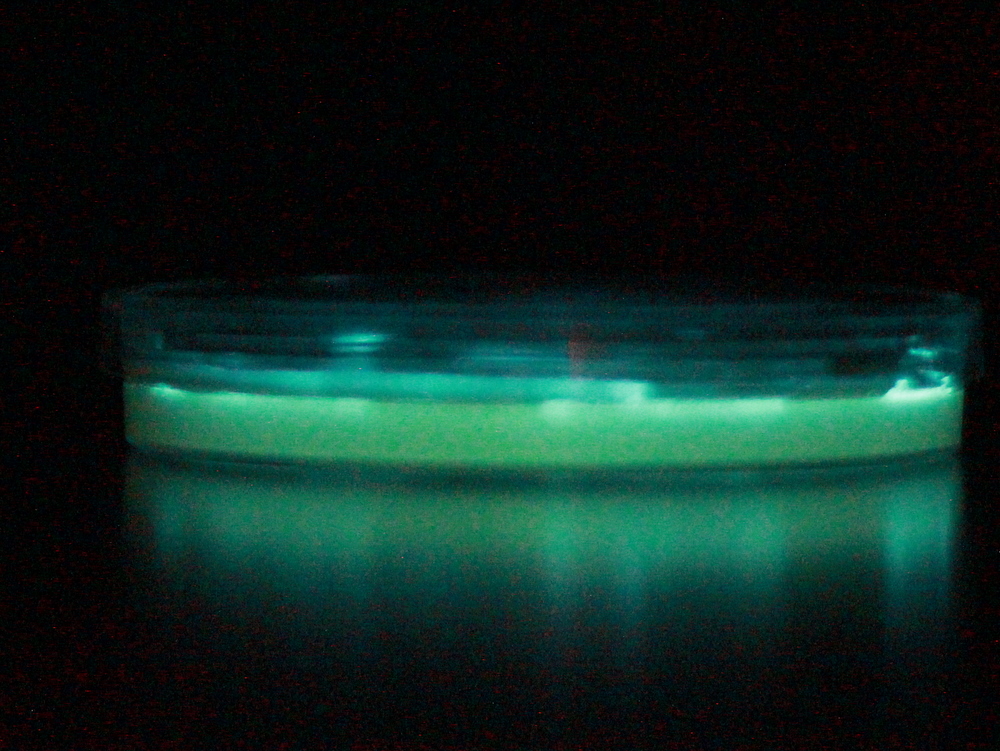Team:Cambridge/Bioluminescence/Bacterial Luciferases
From 2010.igem.org
(Difference between revisions)
(→Bioluminescent species) |
|||
| Line 1: | Line 1: | ||
{{:Team:Cambridge/Templates/headerMinimalprototype}} | {{:Team:Cambridge/Templates/headerMinimalprototype}} | ||
{{:Team:Cambridge/Templates/headerbar|colour=#96d446|title=Bioluminescence: Bacterial Luciferases}} | {{:Team:Cambridge/Templates/headerbar|colour=#96d446|title=Bioluminescence: Bacterial Luciferases}} | ||
| + | {{:Team:Cambridge/Templates/RightImage|image=Cambridge-Photobacterium_plate.JPG|caption=One of the plates of <i>V. phosphoreum</i> we prepared.}} | ||
==Pathway== | ==Pathway== | ||
Bacterial lux operons emit light using five enzymes: | Bacterial lux operons emit light using five enzymes: | ||
| Line 7: | Line 8: | ||
==Bioluminescent species== | ==Bioluminescent species== | ||
The Cambridge team is looking into these bacterial luciferases: | The Cambridge team is looking into these bacterial luciferases: | ||
| - | + | ||
* <i>Vibrio fischeri</i> forms symbioses with squid to prevent the squid from casting a shadow on moonlit nights. Due to this their lux proteins are non-functional above 30 degrees | * <i>Vibrio fischeri</i> forms symbioses with squid to prevent the squid from casting a shadow on moonlit nights. Due to this their lux proteins are non-functional above 30 degrees | ||
* <i>Photorhabdus luminescens</i> lives in the gut of nematodes. The purpose of its bioluminescence is not understood but its lux casette is widely used in reporters | * <i>Photorhabdus luminescens</i> lives in the gut of nematodes. The purpose of its bioluminescence is not understood but its lux casette is widely used in reporters | ||
Revision as of 16:10, 14 August 2010

Bioluminescence: Bacterial Luciferases
Pathway
Bacterial lux operons emit light using five enzymes:
- luxA and luxB form the luciferase part of the system, they emit light using the substrate tetradecanal
- luxC, luxD and luxE are involved in the biosynthesis of tetradecanal from readily available substrates
Bioluminescent species
The Cambridge team is looking into these bacterial luciferases:
- Vibrio fischeri forms symbioses with squid to prevent the squid from casting a shadow on moonlit nights. Due to this their lux proteins are non-functional above 30 degrees
- Photorhabdus luminescens lives in the gut of nematodes. The purpose of its bioluminescence is not understood but its lux casette is widely used in reporters
- Vibrio (formerly Photobacterium) phosophoreum emits a very blue light, perhaps partly through its use of [http://partsregistry.org/Part:BBa_K216007 lumazine]
 "
"
